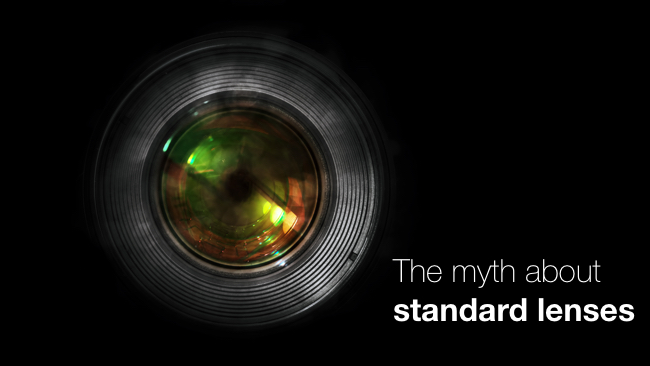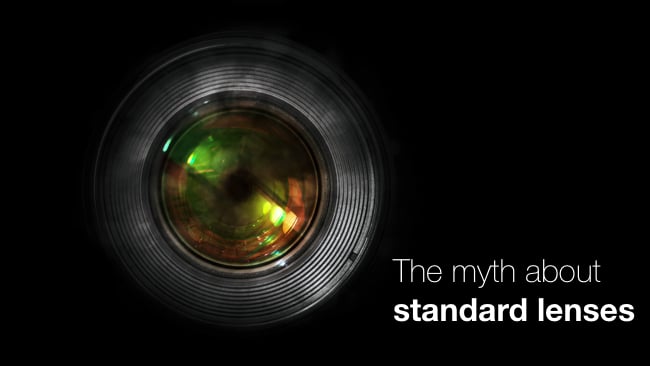
 Lens graphic by www.shutterstock.com
Lens graphic by www.shutterstock.com
Roland Denning on what exactly is meant when we say a lens is 'standard' and why that meaning may be rather more fluid than many would like to admit.
This might seem a simple question, but what is a 'standard lens'? We know it is not a 'wide angle' or a 'telephoto' lens, it's a sort of 'normal' one, but what does that actually mean?
The focal length of a standard lens is generally considered to be about the same as the diagonal measurements of a frame - on a 35mm still camera that would be 43mm, not so far off the 50mm of a 'standard' 35mm lens. But why should that be?
Standard confusion
I Googled the question, and got back some familiar answers. "A standard lens gives a field of view similar to that of a naked eye… it roughly matches what the eye can see." Sorry, that's nonsense! The field of view of the naked eye is something like 200-degrees (that's for both eyes together), way more than that of a 50mm lens, which is more like 40-degrees.
Another answer: "A normal lens gives pretty much the same perspective as viewing a scene with the human eye." But, hang on, perspective (as we have said here many times) is nothing to do with focal length but is dependent on the distance of the camera to the subject. From the same position, the perspective of a 28mm lens is identical to that of a 300mm lens. Nonsense again!
Going back to the 'field of view' argument, our eyes might see a horizontal angle of between 100-degrees and 200-degrees, but is that 40-degrees what our eyes actually concentrate on? That doesn't seem to work either; looking through the viewfinder of a camera with a standard lens definitely looks like a narrowing of our field of view. Even forgetting about all those things that fall within our peripheral vision, our eyes are definitely more 'wide angle' than 'standard'.
Thought experiments
OK, so if I have, say, a monitor set up beside my camera and an empty picture frame the same size beside it, would a standard lens on the camera approximate what I see through the picture frame? Of course, it depends how close I stand to the frame and how large the frame is. All right, so if the frame was 42", the same size as the TV in my living room, would an image shown on that screen shot with a standard lens approximate my field of view if I am looking at the TV at 'normal viewing distance?
To put it another way, if I knocked a hole in my wall above the TV and connected it to a CCTV camera, would a standard lens on that camera give me a similar field of view to what I see through the hole in the wall (say there is an outside wall beside me, at right angles to the screen and the CCTV camera is adjacent to me on that outside wall so we are both same distance from the screen)? That doesn't seem to quite work either, unless you sit uncomfortably close to the screen, the equivalent lens on the camera is rather narrower than that standard 40-degrees (so far this is merely a thought experiment – I haven't yet started hacking holes in my wall, but I'm getting close).
There is something going on here that is to do with viewing distance and screen size and any attempt to approximate the field of view of our eyes has to take that into account. But I'm still not sure what is so 'normal' about a standard lens.
Gauging perspective
Let's look at it another way: does a wide angle lens look abnormal or unnatural? If so, why? Many wide angle lenses distort, but that is mostly an issue with lens design – the best wide-angle lenses don't really distort (I am excluding fish-eye lenses from this discussion) but, nevertheless, there is something 'unnatural' looking if we photograph a portrait very close with a wide-angle lens. This is not so much distortion as an unflattering shift in perspective, because we are closer to the subject than we would be unless we knew them intimately. A classic short-telephoto portrait lens, on the other hand, makes us step away from the subject to a create more flattering perspective: further away from them than we would generally be if we were conversing with them in day-to-day life. A standard lens would give us a close-up of someone from the sort of distance we would be if were having a normal conversation – nothing magical or special about that, just a certain familiarity.
Are we getting somewhere? Perhaps. While it is clear that a long telephoto lens puts us in a place where the only approximation in real life would be looking through a telescope, there does not seem to be anything intrinsically 'unnatural' about the images produced by any lens from a non-distorting wide-angle to a short telephoto.
I have read that a standard lens on a movie camera creates a standard perspective to a viewer sitting in the middle of a cinema looking at a standard size screen (the argument being the closer your are to the screen, the wider the camera lens should be for 'normal' perspective), but there are so many variables at play, the more you think about it (and I've thought about it a lot), the less sense it makes.
Shifting standards?
So is the idea that a standard lens represents some sort of equivalent to the human eye a bit of a myth? I think so, or maybe it is just the fact that lens design is simpler at 'standard' focal lengths. Certainly, on consumer still cameras, what is supplied as standard has tended to get wider over the years as technology changes. This might be so the camera and user have to worry less about focus, but I think it is more a desire to get 'more in the picture'. If you find an old Kodak film camera in the attic, you might be surprised how long that 'standard' lens is. Those whose first introduction to making videos was via the GoPro might be astonished to find 8mm home movie cameras came fitted with what seem to them telephoto lenses.
OK, so maybe we can rid ourselves of the notion that there is anything intrinsically natural about a standard lens. But another thought has occurred in my mind as I was thinking about the relationship between lenses and screen size: as screens at home get larger and larger, should this have an impact on the lenses we use?
We are already talking about 8K, but for a 4K screen to make any sense in the home, it has to be big – much bigger than we are accustomed to. Or we need to sit unusually close – otherwise we might as well stick to HD. At those sort of screen sizes/viewing distances, we are not going to be able to take everything in. Just like in the heyday of Cinerama, 4K or 8K would enable filmmakers to fill our field of vision with vast landscapes, yet enable to us to focus on the details of characters somewhere in the middle of the screen. That could be great for directors who want to play around on a stage of that scale, but what about those stuck with HD or, dare I say, standard definition? Would there be an argument for creating a large screen master then cropping for smaller screens? I know this might evoke horrors of pan-and-scan from the days of fitting Cinemascope films on to SD TVs, but it could be liberating. Of course, this could be a nightmare for delivery systems and viewers on the smaller formats might complain they are not getting all of the picture, but I am struggling to see how a movie that makes the best of 8K could really make sense in HD. OK, this is idle speculation and I don't expect 8K to arrive in the home any time soon (and I also believe 4K delivery will be marginal for the next few years). But it's something to think about.
Graphic by Shutterstock
Tags: Production


Comments